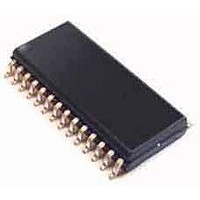CS8427-CZZ Cirrus Logic Inc, CS8427-CZZ Datasheet - Page 39

CS8427-CZZ
Manufacturer Part Number
CS8427-CZZ
Description
Audio DSPs 96 kHz Digital Audio Transceiver
Manufacturer
Cirrus Logic Inc
Datasheet
1.CS8427-DZZ.pdf
(60 pages)
Specifications of CS8427-CZZ
Operating Supply Voltage
4.5 V to 5.5 V
Supply Current
6.3 mA to 76.6 mA
Operating Temperature Range
- 10 C to + 70 C
Mounting Style
SMD/SMT
Input Voltage
4.8 V to 5.8 V
Package / Case
TSSOP-28
Rohs Compliant
Yes
Supply Voltage Range
4.5V To 5.5V
Logic Case Style
TSSOP
No. Of Pins
28
Supply Voltage Max
5.5V
Supply Voltage Min
4.5V
Lead Free Status / RoHS Status
Lead free / RoHS Compliant
Available stocks
Company
Part Number
Manufacturer
Quantity
Price
Company:
Part Number:
CS8427-CZZ
Manufacturer:
CIRRUS
Quantity:
67
Part Number:
CS8427-CZZ
Manufacturer:
CIRRUS
Quantity:
20 000
12. PIN DESCRIPTION - SOFTWARE MODE
DS477F5
SDA/CDOUT
AD0/CS
EMPH
RXP
RXN
VA+
AGND
FILT
RST
RMCK
10
1
2
3
4
5
6
7
8
9
Serial Control Data I/O (I²C) / Data Out (SPI) (Input/Output) - In I²C mode, SDA is the con-
trol I/O data line. SDA is open drain and requires an external pull-up resistor to VL+. In SPI
mode, CDOUT is the output data from the control port interface on the CS8427
Address Bit 0 (I²C) / Control Port Chip Select (SPI) (Input) - A falling edge on this pin puts
the CS8427 into SPI control port mode. With no falling edge, the CS8427 defaults to I²C
mode. In I²C mode, AD0 is a chip address pin. In SPI mode, CS is used to enable the control
port interface on the CS8427
Pre-Emphasis (Output) - EMPH is low when the incoming Channel Status data indicates
50/15 ms pre-emphasis. EMPH is high when the Channel Status data indicates no pre-
emphasis or indicates pre-emphasis other than 50/15 ms. This is also a start-up option pin,
and requires a 47 kΩ resistor to either VL+ or DGND, which determines the AD2 address bit
for the control port in I²C mode
Differential Line Receiver (Input) - Receives differential AES3 data.
Positive Analog Power (Input) - Positive supply for the chip’s analog section. Nominally
+5.0 V. This supply should be as quiet as possible since noise on this pin will directly affect
the jitter performance of the recovered clock
Analog Ground (Input) - Ground for the analog section. AGND should be connected to the
same ground as DGND
PLL Loop Filter (Output) - An RC network should be connected between this pin and
ground. See “Appendix C: PLL Filter” on page 55 for recommended schematic and compo-
nent values.
Reset (Input) - When RST is low, the CS8427 enters a low power mode and all internal
states are reset. On initial power up, RST must be held low until the power supply is stable,
and all input clocks are stable in frequency and phase. This is particularly true in hardware
mode with multiple CS8427 devices where synchronization between devices is important
Input Section Recovered Master Clock (Input/Output) - Input section recovered master
clock output when PLL is used. Frequency defaults to 256x the sample rate (Fs) and may be
set to 128x. When the PLL is bypassed by the RXD[1:0] bits in the Clock Source Control reg-
ister, an external clock of 256 Fs may be applied to this pin
SDA/CDOUT
* Pins which remain the same function in all modes.
+ Pins which require a pull up or pull down resistor
AD0/CS
to select the desired startup option.
ILRCK
RMCK
ISCLK
EMPH
AGND
RERR
SDIN
RXN
RXP
FILT
RST
VA+
1
2
3+
4*
5*
6*
7*
8*
9*
10*
11*
12*
13*
14*
*26
*25
*24
*23
*22
*18
*17
*16
*15
28
27
21
20
19
SCL/CCLK
AD1/CDIN
TXP
TXN
H/S
V +
DGND
OMCK
U
INT
SDOUT
OLRCK
OSCLK
TCBL
L
CS8427
39


















